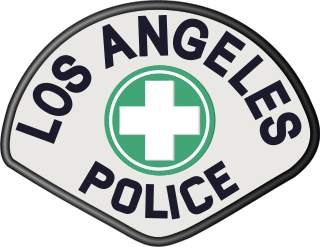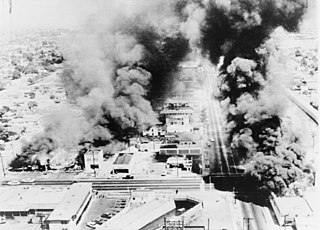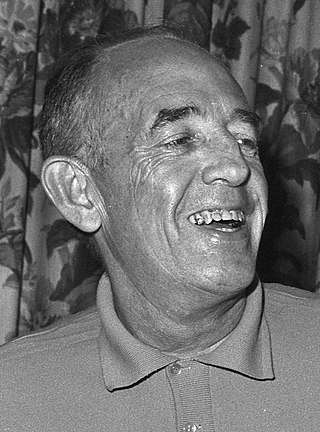
Rodney Glen King was an African American man who was a victim of police brutality. On March 3, 1991, he was severely beaten by officers of the Los Angeles Police Department (LAPD) during his arrest after a high speed pursuit for driving while intoxicated on the I-210. An uninvolved resident, George Holliday, saw and filmed the incident from his nearby balcony and sent the footage, which showed the unarmed King on the ground being beaten after initially evading arrest, to local news station KTLA. The incident was covered by news media around the world and caused a public uproar.

The Los Angeles Police Department (LAPD), officially known as the City of Los Angeles Police Department, is the primary law enforcement agency of Los Angeles, California, United States. With 8,967 officers and 3,000 civilian staff, it is the third-largest municipal police department in the United States, after the New York City Police Department and the Chicago Police Department.

The Watts riots, sometimes referred to as the Watts Rebellion or Watts Uprising, took place in the Watts neighborhood and its surrounding areas of Los Angeles from August 11 to 16, 1965.
A Los Angeles Police Department C.R.A.S.H. initiative that began in April 1987, Operation Hammer was a large scale attempt to crack down on gang violence in Los Angeles, California. A year later, the LA Times reported a double-digit drop in gang violence in parts of the city. After a group of people at a birthday party were shot down on their front lawn in a drive-by shooting, Chief of Police Daryl F. Gates responded with a roundup of gang members. At the height of this operation in April 1988, 1,453 people were arrested by one thousand police officers in South Central Los Angeles in a single weekend.

The Community Resources Against Street Hoodlums (CRASH) was a specialized gang intelligence unit of the Los Angeles Police Department (LAPD) tasked with combating gang-related crime between 1979 and 2000. The unit was established in the South Central district of Los Angeles, California, United States, to combat rising gang violence during the period. Each of the LAPD's 18 divisions had a CRASH unit assigned to it, whose primary goal was to suppress gang-related crimes in the city, which came about primarily from the increase in illegal drug trade.
The Independent Commission on the Los Angeles Police Department, informally known as the Christopher Commission, was formed by then-mayor of Los Angeles Tom Bradley in April 1991, in the wake of the Rodney King beating.

Daryl Francis Gates was an American police officer who served as chief of the Los Angeles Police Department from 1978 to 1992. His length of tenure in this position was second only to that of William H. Parker. Gates is credited with the creation of SWAT teams alongside fellow Los Angeles Police Department (LAPD) officer John Nelson, who others claim was the originator of SWAT in 1965. Gates also co-founded the Drug Abuse Resistance Education program.

The 1992 Los Angeles riots, were a series of riots and civil disturbances that occurred in Los Angeles County, California, United States, during April and May 1992. Unrest began in South Central Los Angeles on April 29, after a jury acquitted four officers of the Los Angeles Police Department (LAPD) charged with using excessive force in the arrest and beating of Rodney King. The incident had been videotaped by George Holliday, who was a bystander to the incident, and was heavily broadcast in various news and media outlets.

The Rampart scandal was a police corruption scandal which unfolded in Los Angeles, California, United States, during the late 1990s and early 2000s. The scandal concerned widespread criminal activity within the Community Resources Against Street Hoodlums (CRASH) anti-gang unit of the Los Angeles Police Department's Rampart Division. More than 70 police officers were initially implicated in various forms of misconduct, including unprovoked shootings and beatings, planting of false evidence, stealing and dealing narcotics, bank robbery, perjury, and cover-ups thereof.
The Fuhrman tapes are 13 hours of taped interviews given by Mark Fuhrman, former detective of the Los Angeles Police Department, to writer Laura McKinny between 1985 and 1994.

James Edgar Davis was an American police officer who served as the chief of the Los Angeles Police Department (LAPD) from 1926 to 1929, and from 1933 to 1939. During his first term as LAPD chief, Davis emphasized firearms training. Under Davis, the LAPD developed its lasting reputation as an organization that relied on brute force to enforce public order. It also became publicly entangled in corruption. Members of the LAPD were revealed to have undertaken a campaign of brutal harassment, including the bombings of political reformers who had incurred the wrath of the department and the civic administration.

William Henry Parker III was an American law enforcement officer who was Chief of the Los Angeles Police Department (LAPD) from 1950 to 1966. To date, he is the longest-serving LAPD police chief. Parker has been called "Los Angeles' greatest and most controversial chief of police". The former headquarters of the LAPD, the Parker Center, was named after him. During his tenure, the LAPD was known for police brutality and racism; Parker himself was known for his "unambiguous racism".

Michael Zinzun was an African American Black Panther and anti-police brutality activist.

The Los Angeles Police Department (LAPD) was formed in 1869, and has since become the third-largest law enforcement agency in the United States. They have been involved in various events in history, such as the Black Dahlia murder, the Watts riots, the 1992 Los Angeles riots, the North Hollywood shootout, the murder trial of O. J. Simpson, and the Rampart scandal.
The 2007 MacArthur Park rallies were two May Day rallies demanding amnesty for undocumented immigrants which occurred on May 1, 2007, at MacArthur Park, in Los Angeles.

Metropolitan Division, commonly referred to as Metro Division or just Metro, is an elite division of the Los Angeles Police Department (LAPD) under its Special Operations Group. Metropolitan Division is responsible for managing the LAPD's specialized crime suppression, K-9, mounted, and SWAT units, named "platoons".
Dragnet was an American radio series, enacting the cases of a dedicated Los Angeles police detective, Sergeant Joe Friday, and his partners. The show took its name from the police term dragnet.

The Gangster Squad, later known as the OrganizedCrime Intelligence Division (OCID), was a special unit of the Los Angeles Police Department (LAPD) formed in 1946 to keep the East Coast Mafia and organized crime elements out of Los Angeles.

Ezell Ford, a 25-year-old African-American man, died from multiple gunshot wounds after being shot by Los Angeles Police Department (LAPD) officers in Florence, Los Angeles, California on August 11, 2014. In the weeks and months that followed, Ford's shooting triggered multiple demonstrations and a lawsuit by Ford's family claiming $75 million in damages.
The 1967 Century City demonstrations, also known as the 1967 Century City police riots, was an anti-Vietnam War protest which took place on June 23, 1967, in the Century City neighborhood of Los Angeles. Beginning with a demonstration against the war by an estimated 10,000 protestors, the march was soon stopped and LAPD officers began attacking, later claiming they believed that a mob was forming. In the end, 51 arrests were made and an unknown number of protesters were left injured.













